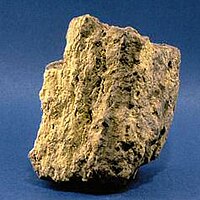
Photo from wikipedia
Abstract Bleaching of red-bed sandstones is an important process related to the organic-inorganic interactions and diagenetic alteration, playing an important role in reservoir heterogeneity and carbon cycle in petroliferous basins.… Click to show full abstract
Abstract Bleaching of red-bed sandstones is an important process related to the organic-inorganic interactions and diagenetic alteration, playing an important role in reservoir heterogeneity and carbon cycle in petroliferous basins. Distinguishing from the aeolian red-bed in the outcrop, a case study of deep red-bed of fluvial facies was conducted on the Permian Xiashihezi Formation, NE Ordos Basin, China. Four diagenetic facies can be identified as red, brown, green and white sandstones (RS, BS, GS, WS) with typical diagenetic alteration and geochemical characteristics. Thereinto, diagenetic alterations are dominated by clay minerals and carbonate cements including calcite and siderite. Carbon and oxygen isotopes showed a synergistic decreasing trend from RS, BS to WS with the increase of altered degree. The unaltered RS retained abundant early hematite, smectite and calcite, while strongly bleached WS had lowest feldspar but extensive kaolinite and illite, and manganese-rich calcite. Medium-altered BS and GS are characterized by late magnesium-rich siderite and chlorite coating respectively. The isotopic data, fluid inclusions and modeling indicated that CH4 is the important causal fluid for sandstones bleaching. Diagenetic alteration and geochemical evolution in deep red-bed of fluvial facies was influenced by upward-fining sedimentary sequence, open/closed diagenetic system and natural gas migration. The geochemical behaviors of Fe are responsible for the diversity of diagenetic facies. Fe2+ from redox between Fe3+ and CH4, integrated Mg2+ released from the transformation of smectite to illite into magnesium-rich siderite, or into chlorite in coarser sandstones in relatively open system. Extensive CH4-rich reducing fluids were oxidized to acidic fluids in the more open diagenetic system with coarser grained sandstones, resulting in the intense dissolution and the high-quality reservoirs distributed in the lower sequence of fluvial facies. Furthermore, CH4 oxidation by Fe(III) in deep red-bed can be extremely important CH4 sink and expected to potential sites of geological carbon sequestration.
Journal Title: Marine and Petroleum Geology
Year Published: 2021
Link to full text (if available)
Share on Social Media: Sign Up to like & get
recommendations!